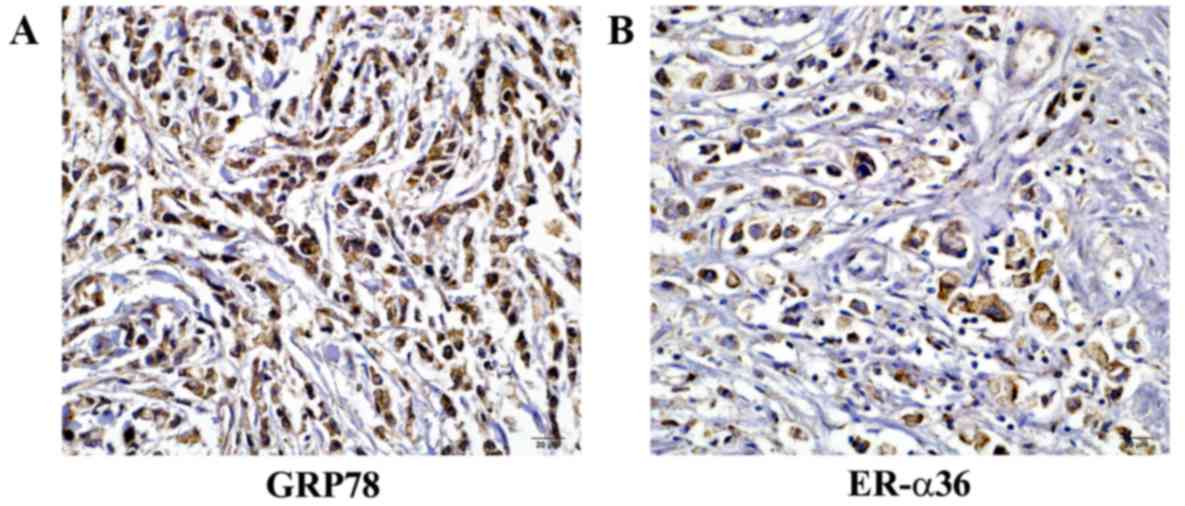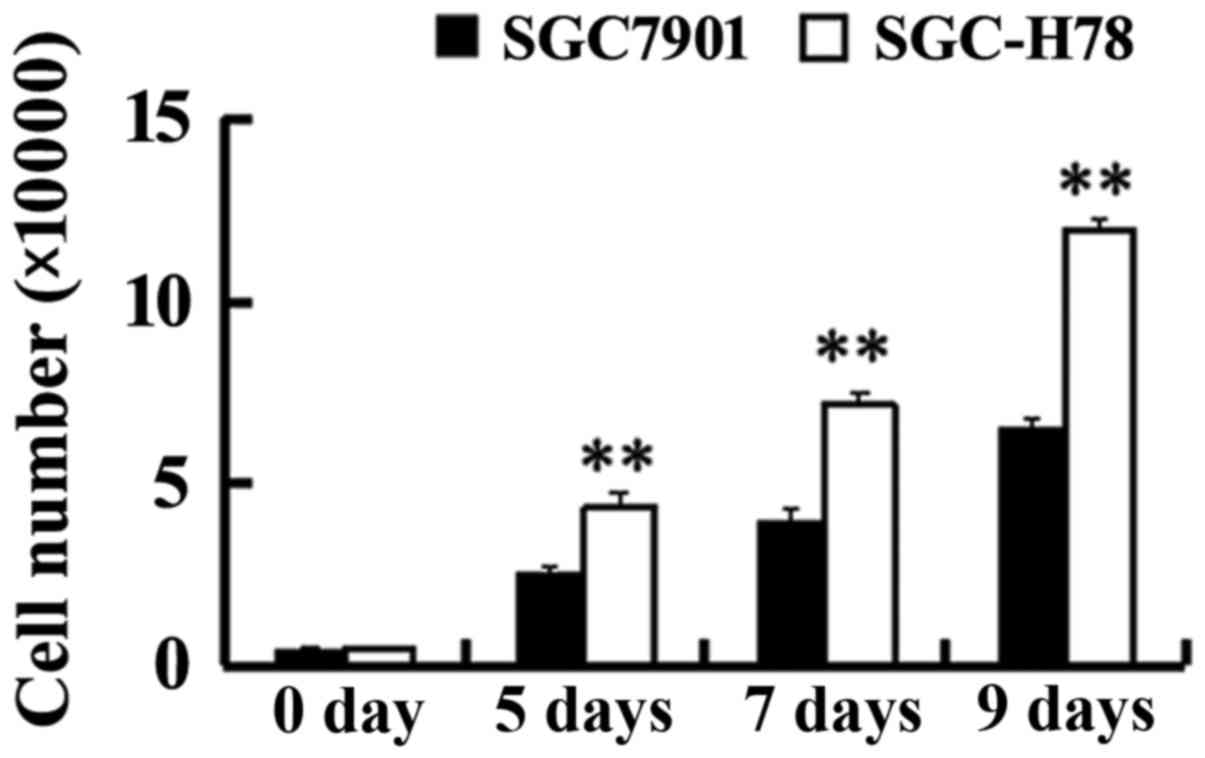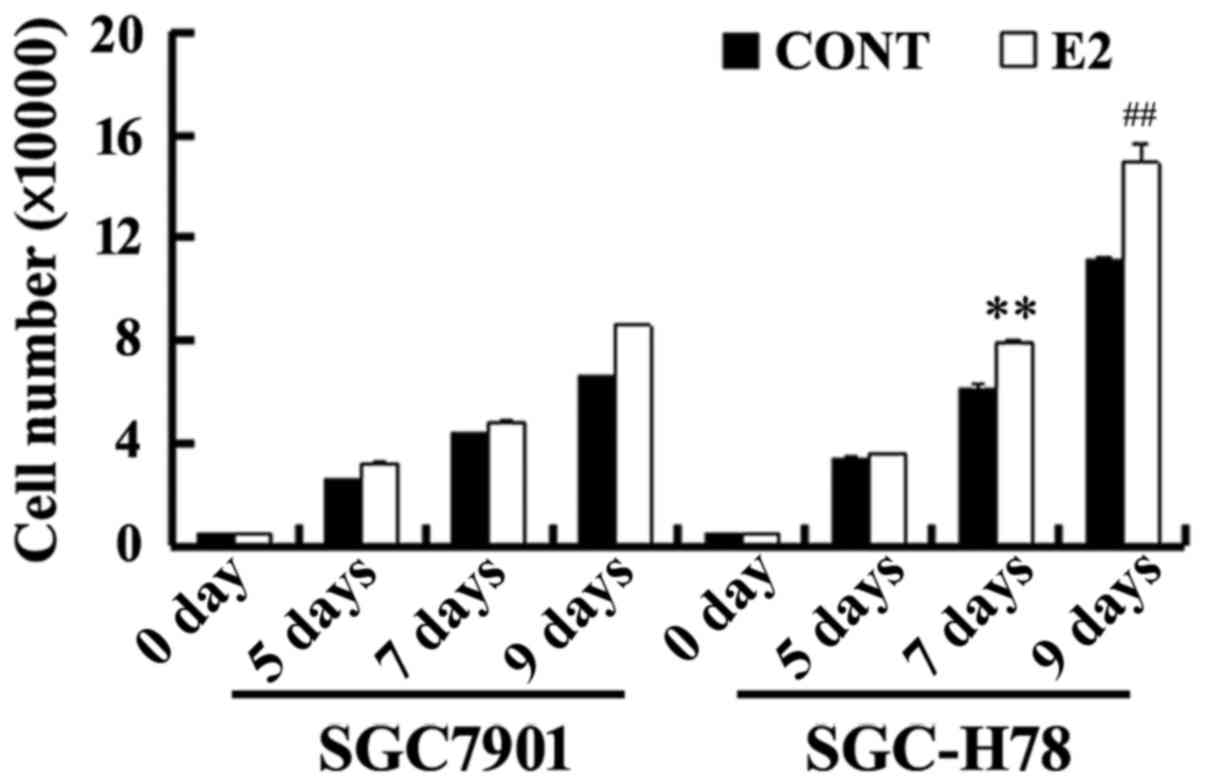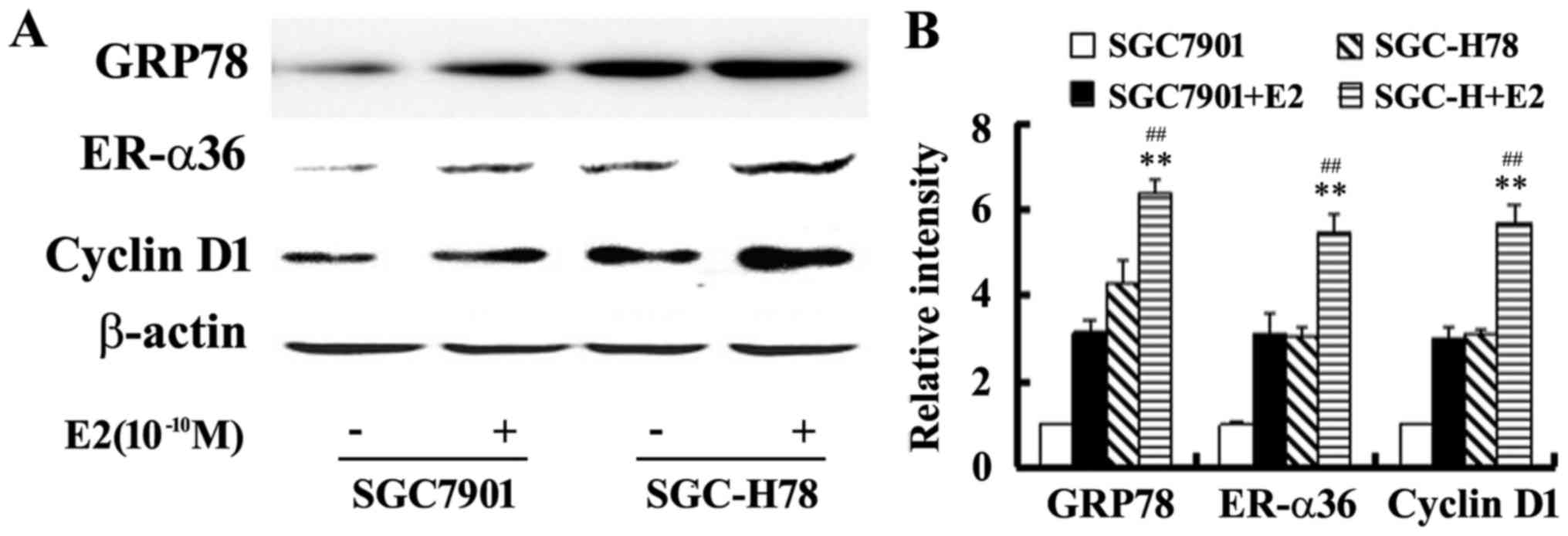GRP78 positively regulates estrogen‑stimulated cell growth mediated by ER‑α36 in gastric cancer cells
- Authors:
- Published online on: September 26, 2017 https://doi.org/10.3892/mmr.2017.7615
- Pages: 8329-8334
Abstract
Introduction
Gastric tumor is the type of tumor with the third highest mortality rate worldwide and is the second most frequently-diagnosed type of cancer in China (1,2). Traditionally, gastric tumor was considered to be unrelated to estrogen signaling. Epidemiological studies reported a male predominance in gastric cancer (male/female ratio of 2-3:1), and it has been proposed that there may be a protective function of estrogen in gastric tumorigenesis (3,4). However, studies into the expression patterns of estrogen receptor (ER)-α in samples from gastric tumor patients were inconsistent (5,6). ER-α expression was frequently low and variable (0–62.5%) in gastric cancer specimens (5). ER-β was considered to be an inhibitory factor in the invasiveness of gastric tumor. Therefore, ER-β-positivity has been proposed as a prognostic marker (6). A previous study demonstrated that a novel isoform, ER-α36, was expressed in specimens from patients with gastric cancer (7). Upregulated expression of ER-α36 was positively associated with large size, increased nuclear fission, increased proliferation marker protein Ki-67 expression and decreased E-cadherin expression (8). However, the potential role of ER-α36 in gastric carcinogenesis remains to be determined.
ER-α36 is predominantly expressed in the cytoplasm and at the cell membrane, unlike ER-α which is primarily in the cell nucleus (9–11). In breast cancer, ER-α36-mediated signaling positively regulates ER-positive stem/progenitor cells (12), and it serves an important role in the malignant growth of ER-negative breast tumor cells via the mitogen-activated protein kinase (MAPK)/extracellular signal-regulated kinase (ERK) signaling pathway (13). In gastric tumor cells, ER-α36 conducts biphasic estrogen signaling (14). A decreased concentration of estrogen (0.1 nM) has been demonstrated to promote cell growth, while a high concentration (1 µM) inhibited cell growth (8,15). However, the mechanism underlying estrogen signaling in cell growth of the gastric tumor is still unclear.
The 78 kDa glucose-regulated protein (GRP78) is a stress-inducible chaperone, and maybe induced under tumor microenvironmental stress conditions (16). GRP78 has been implicated in cancer cell growth, invasion, metastasis and angiogenesis (15,17,18). In gastric carcinoma, GRP78 overexpression is positively-correlated with larger tumor size, increased invasion and advanced stage (19). Targeting GRP78 in gastric cancer leads to a more effective therapeutic outcome (20). GRP78 expression suppressed apoptosis induced by serine/threonine-protein kinase BIK in estrogen-deprived breast cancer cells (21). GRP78 expression is induced by treatment with estrogen in endometrial cancer cells (22). A previous study demonstrated that elevated endoplasmin (GRP94) expression, another protein in the heat shock protein family, was correlated with tumor malignancy and upregulated expression of ER-α36 in gastric tumor cells (23,24). In breast cancer, GRP94 was reported to positively-regulate ER-α36 expression, and enhance cell proliferation and invasion (25). However, the potential role and mechanism through which GRP78 may regulate ER-α36 signaling remains unclear.
In the present study, GRP78 and ER-α36 expression patterns in samples from patients with gastric tumor, in addition to the correlation between their expression levels and clinicopathological features, were analyzed. GRP78, ER-α36 and cyclin D1 expression in established gastric tumor cells with overexpressed GRP78, and the cell growth of these cells following treatment with estrogen, were additionally investigated.
Materials and methods
Reagents
17β-estradiol (E2) was obtained from Sigma-Aldrich (Merck KGaA, Darmstadt, Germany). E2 was dissolved in absolute alcohol (Sinopharm Chemical Reagent Co., Ltd, Shanghai, China) at a concentration of 10 mM, and then stored at −20°C for cell treatment. The rabbit polyclonal antibody recognizing GRP78 (cat. no. ab21685) was from Abcam (Cambridge, UK). The mouse monoclonal Cyclin D1 antibody was purchased from ProteinTech Group, Inc. (Chicago, IL, USA; cat. no. 60186-1-Ig). The rabbit polyclonal ER-α36 antibody was provided by D. Zhaoyi Wang, Shenogen Pharma Group (Beijing, China). The antibody was generated using the custom service provided by the Pacific Immunology (Ramona, CA, USA) using the last 20 amino acids of ER-α36 encoded by exon 9 which are unique to ER-α36 as an immunogen. The produced antibody was purified using an affinity column consisting of immunogen peptides (9–11). The monoclonal β-actin antibody (cat. no. sc-47778) and the horseradish peroxidase-conjugated antibodies (cat. nos. sc-2004 and sc-2005) were obtained from Santa Cruz Biotechnology, Inc. (Dallas, TX, USA). A lentiviral expression vector (Lenti-HSPA5) and a lentiviral vector expressing GFP alone (LV-control) were constructed and produced by Shanghai GeneChem Co., Ltd. (Shanghai, China). The SuperPicture 3rd Gen Immunohistochemistry kit was purchased from Invitrogen (Thermo Fisher Scientific, Inc., Waltham, MA, USA). The Enhanced Bicinchoninic Acid (BCA) Protein Assay kit and radioimmunoprecipitation assay (RIPA) buffer were purchased from Beyotime Institute of Biotechnology (Haimen, China).
Cell culture and treatments
SGC7901 cells were obtained from Tongji Medical College (Wuhan, China). A stable cell line with overexpressed GRP78 (SGC-High78 cells) and a control cell line were generated by Shanghai GeneChem Co., Ltd. SGC7901 and SGC-High78 cells were maintained in RPMI-1640 medium (Gibco; Thermo Fisher Scientific, Inc.) with 10% fetal calf serum (FCS; Zhejiang Tianhang Biotechnology Co., Ltd., Zhejiang, China) in a 5% CO2 atmosphere at 37°C. For E2 treatment, the cells were maintained in phenol red-free RPMI-1640 medium (Gibco; Thermo Fisher Scientific, Inc.) with 5% charcoal-stripped FCS (Biological Industries, Beit-Heamek, Israel) for 6 h at 37°C, and then in 2% charcoal-stripped FCS for 24 h at 37°C prior to experiments; the same volume of alcohol was used as the control.
Cell proliferation assay
Cells (3×103/well) were seeded and then treated with 0.1 nM E2 for 5, 7 and 9 days were assessed using the Scepter™ 2.0 automated cell counter (Merck KGaA). All experiments were repeated three times with three 6-well plates for each point.
Gastric tumor samples
Tissue from 136 patients with gastric cancer between January 2006 and December 2010 were obtained from the Jiangda Pathology Institute (Wuhan, China) with Institutional Review Board approval and written informed consent. The samples were obtained from 100 men and 36 women aged between 34 and 82 years (mean age, 56.84 years), and all samples were fixed in 10% formalin at room temperature for 1 day prior to paraffin-embedding. No patient had received any anticancer therapy prior to surgery. Tumor size, differentiation and staging were assessed according to the classification system of the World Health Organization (2013).
Tissue microarray
Representative areas of the tumors were identified by hematoxylin and eosin (H&E)-staining of the sections obtained from patients. Briefly, a 0.6-mm in diameter tissue core block (1 per donor) was punched out of each sample and transferred to a recipient block (novel paraffin block containing a maximum of 130 patient core samples), using a tissue microarrayer MTA-1 (Beecher Instruments, Inc., Sun Prairie, WI, USA). Consecutive 4-µm-thick sections were cut from the recipient block and transferred to polylysine-coated glass slides. H&E staining (Mayer's hematoxylin for 2 min and 1% eosin for 30 sec at room temperature) was performed on the tissue microarray to check the quality of the sections prior to experiments.
Western blot analysis
Western blotting was performed as previously described (26,27). Cells were harvested, washed and lysed in RIPA buffer. Following determination of the protein concentration using the BCA kit, the samples were separated using SDS-PAGE on a 10% gel and then blotted to polyvinylidene fluoride filters (EMD Millipore, Billerica, MA, USA). The filters were blocked in buffer containing 5% nonfat milk for 1 h, and detected with appropriate primary antibodies at 4°C overnight. The dilutions of the antibodies were as follows: GRP78, 1:1,000; ER-α36, 1:1,000; cyclin D1, 1:1,000; and β-actin, 1:5,000. The blots were subsequently probed with secondary antibodies for 1 h at 37°C, visualized using enhanced chemiluminescence, and quantitatively analyzed using Totallab version TL120 analysis software (Nonlinear Dynamics Ltd., Newcastle upon Tyne, UK).
Immunohistochemistry assay
Immunohistochemical analysis was performed as previously described (7). The slides were dewaxed in xylene and gradually rehydrated. Antigen retrieval was performed in EDTA buffer (pH 8.0) and by boiling in a water bath for 20 min. The samples were rinsed, incubated with antibodies against GRP78 (1:400) or ER-α36 (1:400) overnight at 4°C, and with the secondary antibody (horseradish peroxidase-conjugated goat anti-rabbit immunoglobulin; 1:100; cat. no. A16096; Invitrogen; Thermo Fisher Scientific, Inc.) at 37°C for 30 min, prior to counterstaining with hematoxylin at room temperature for 5 min. The slides were independently evaluated using a light microscope (Olympus BX51; ×10 ocular magnification) by two pathologists in a blinded manner.
Statistical analysis
The association between GRP78 expression, clinical pathological features and ER-α36 expression was examined using the Pearson χ2 test. SPSS 12.0 software (SPSS Inc., Chicago, IL, USA) was employed for statistical analysis. Data are presented as the mean ± standard error of the mean. Statistical analysis was performed using one-way analysis of variance, followed by Bonferroni's post hoc test. P<0.05 was considered to indicate a statistically significant difference.
Results
Association between GRP78, ER-α36 expression and clinicopathological properties of gastric tumor samples
GPR78 expression was assessed in 136 specimens by immunohistochemical analysis. GRP78 and ER-α36 were detected in the cytoplasm of gastric cancer cells (Fig. 1). GRP78 expression (2+ or 3+) was observed in 95 of the cases of gastric carcinoma (95/136; 69.85%). ER-α36 expression (2+ or 3+) was observed in 110 out of the 136 cases (80.88%) (Table I).
Table I.Association between GRP78 expression, clinicopathological features of gastric carcinoma, and ER-α36 expression. |
Analysis of the association between GRP78 expression and the clinical pathological characteristics of gastric cancer specimens was performed. High GRP78 was positively-associated with tumor stage (P<0.01) and an increased incidence of lymphatic metastasis (P<0.05), although no association was observed with age, gender, histological differentiation and tumor size (P>0.05). Compared with female patients, GRP78 positivity was detected in more male patients (male-to-female ratio, 2.78:1; Table I).
A positive association between GPR78 and ER-α36 expression (P<0.05; Table I) was observed, suggesting that GPR78 and ER-α36 may be involved in gastric tumorigenesis.
Estrogen induces GRP78 and ER-α36 expression
Estrogen-deprived SGC7901 cells were cultured in the presence of E2 at a concentration of 0.1 nM for 24 h to determine whether estrogen is able to regulate GRP78 expression. GRP78 expression was assessed by western blotting. It was demonstrated that a low concentration of E2 upregulated GPR78 and ER-α36 expression in SGC7901 cells (Fig. 2).
Increased ER-α36 and cyclin D1 expression, and enhanced growth in GRP78 expressing cells
In order to study the role and potential mechanism of GRP78 in the growth of gastric tumor cells, SGC-High78 cells that overexpressed recombinant GRP78 and SGC-Control cells were examined for cell growth. It was observed that SGC-High 78 cells exhibited a higher growth rate compared with SGC7901-Control cells (Fig. 3). A significant increase in ER-α36 and cyclin D1 expression was noted in the cells with overexpressed GRP78, compared with SGC-Control cells (Fig. 4), indicating that upregulated ER-α36 expression in GPR78-expressing cells may be important for the increased cell growth of GPR78-expressing cells.
GRP78 induces ER-α36 and cyclin D1 expression via estrogen in gastric tumor cells
In order to confirm the function of GRP78 in the responsiveness of gastric tumor cells to estrogen SGC-High78 cells overexpressing recombinant GRP78 and SGC7901-Control cells were treated with E2 at a concentration of 0.1 nM for different time periods, and cell growth was examined. As presented in Fig. 5, SGC-High78 cells exhibited an increased growth rate with treatment with estrogen compared with SGC7901-Control cells. Western blot analysis illustrated that E2 upregulated the levels of GRP78, ER-α36 and cyclin D1 expression, and these increases were more marked in SGC-High78 cells compared with those in SGC-Control cells (Figs. 5 and 6). The results of the present study suggested that overexpressed GRP78 promoted the growth of gastric tumor cells via upregulation of ER-α36 signaling.
Discussion
ER-α36 expression has been reported in gastric, breast, lung and endometrial cancer, and its function is associated with the carcinogenesis and progression of these tumors (7,11,28,29). In gastric tumor, increased ER-α36 expression was associated with more advanced lymphatic metastasis (7). ER-α36 enhanced the growth of gastric tumor cells by augmenting proto-oncogene tyrosine-protein kinase Src (Src) signaling and upregulating cyclin D1 expression (14). In the present study, GRP78 and ER-α36 were expressed in gastric tumor specimens. Estrogen promoted gastric cancer cell growth and upregulated GRP78 and ER-α36 in SGC7901 cells. The result of the present study suggested an involvement of GRP78 in the estrogen-enhanced growth of gastric tumor cells via the ER-α36 signaling pathway.
ER-α36 is primarily expressed in the cytoplasm and at the plasma membrane. ER-α36 mediates the membrane-initiated rapid estrogen pathway and inhibits genomic estrogen signaling mediated by ER-α66 and ER-β, and it functions as an important factor in the increased cell growth and tumorigenesis of breast cancer stimulated by estrogen (9,30). Estrogen has been demonstrated to stimulate the growth of gastric cancer cells (14,15). It has been reported that cells with high levels of ER-α36 require lower concentrations of estrogen (in the pM range) to enhance cell growth, compared with cells expressing low levels of the receptor (13). In the present study, a low concentration of estrogen (equivalent to the level observed in postmenopausal women) was demonstrated to promote gastric tumor cell growth and to increase GRP78 and ER-α36 expression, which provided a potential explanation for the observed male predominance in gastric tumor and a possible mechanism underlying postmenopausal ER-α36-mediated rapid estrogen signaling in gastric tumorigenesis.
It was additionally demonstrated in the present study that GRP78 expression was positively associated with tumor stage, increased lymphatic metastasis and ER-α36 expression in gastric carcinoma specimens. In addition, a higher growth rate, and increased levels of ER-α36 and cyclin D1, were detected in cells with GRP78 overexpression. Cells with overexpressed GRP78 were more sensitive to treatment with estrogen and the growth rate of these cells was higher, with increased ER-α36 and cyclin D1 expressions compared with SGC-Control cells. The present findings suggested that ER-α36 may be positively regulated by GRP78, and may be involved in the cell growth of gastric tumors. A recent report indicated that GRP94, a scaffold protein, stabilized cell membrane ER-α36 and upregulated its levels in breast cancer (25). Targeting GRP94 with a specific small interfering RNA or a specific monoclonal inhibited ER-α36-driven cell growth in vitro and in vivo (25). A previous study reported that the GRP94 expression level was upregulated by ER-α36 in gastric cancer cells (23,24). In established gastric cancer cells with knockdown of ER-α36 expression, GRP94 was markedly reduced (23). ER-α36 was reported to be involved in the testosterone-stimulated activation of the MAPK/ERK and phosphatidylinositol 3-kinase/RAC-α serine/threonine protein kinasesignaling pathways in endometrial cancer Hec1A cells (29). E2 induced MAPK/ERK activation via a mechanism involving ER-α36 and the epidermal growth factor receptor/Src/SHC transforming protein 1complex (31). Therefore, it is possible that there exists a positive regulatory loop between GRPs and ER-α36 expression, although the mechanism underlying their association with tumorigenesis requires further investigation.
In conclusion, GRP78 expression was positively correlated with advanced tumor stage, increased lymphatic metastasis and increased ER-α36 expression in specimens from patients with gastric tumors. ER-α36-mediated signaling positively regulated by GRP78 enhanced cell growth in gastric tumors. The results of the present study thereby provided evidence that GRP78 may function as an important regulator in the estrogen-enhanced growth of gastric tumor through ER-α36 signaling.
Acknowledgements
The present study was supported by the National Natural Science Foundation of China (grant no. 81402315).
References
|
Torre LA, Bray F, Siegel RL, Ferlay J, Lortet-Tieulent J and Jemal A: Global cancer statistics, 2012. CA Cancer J Clin. 65:87–108. 2015. View Article : Google Scholar : PubMed/NCBI | |
|
Chen W, Zheng R, Baade PD, Zhang S, Zeng H, Bray F, Jemal A, Yu XQ and He J: Cancer statistics in China, 2015. CA Cancer J Clin. 66:115–132. 2016. View Article : Google Scholar : PubMed/NCBI | |
|
Camargo MC, Goto Y, Zabaleta J, Morgan DR, Correa P and Rabkin CS: Sex hormones, hormonal interventions, and gastric cancer risk: A meta-analysis. Cancer Epidemiol Biomarkers Prev. 21:20–38. 2012. View Article : Google Scholar : PubMed/NCBI | |
|
Lindblad M, Ye W, Rubio C and Lagergren J: Estrogen and risk of gastric cancer: A protective effect in a nationwide cohort study of patients with prostate cancer in Sweden. Cancer Epidemiol Biomarkers Prev. 13:2203–2207. 2004.PubMed/NCBI | |
|
Wang M, Pan JY, Song GR, Chen HB, An LJ and Qu SX: Altered expression of estrogen receptor alpha and beta in advanced gastric adenocarcinoma: Correlation with prothymosin alpha and clinicopathological parameters. Eur J Surg Oncol. 33:195–201. 2007. View Article : Google Scholar : PubMed/NCBI | |
|
Ryu WS, Kim JH, Jang YJ, Park SS, Um JW, Park SH, Kim SJ, Mok YJ and Kim CS: Expression of estrogen receptors in gastric cancer and their clinical significance. J Surg Oncol. 106:456–461. 2012. View Article : Google Scholar : PubMed/NCBI | |
|
Deng H, Huang X, Fan J, Wang L, Xia Q, Yang X, Wang Z and Liu L: A variant of estrogen receptor-alpha, ER-alpha36 is expressed in human gastric cancer and is highly correlated with lymph node metastasis. Oncol Rep. 24:171–176. 2010.PubMed/NCBI | |
|
Wang XM, Liu JJ, Deng H, Chen Y and Liu LJ: ER-α36 promotes the growth of SGC-7901 cells in nude mice. World Chin J Digestol. 19:2919–2924. 2011.(In Chinese). View Article : Google Scholar | |
|
Wang ZY and Yin L: Estrogen receptor alpha-36 (ER-α36): A new player in human breast cancer. Mol Cell Endocrinol 418 Pt. 3:193–206. 2015. View Article : Google Scholar | |
|
Wang Z, Zhang X, Shen P, Loggie BW, Chang Y and Deuel TF: Identification, cloning, and expression of human estrogen receptor-alpha36, a novel variant of human estrogen receptor-alpha66. Biochem Biophys Res Commun. 336:1023–1027. 2005. View Article : Google Scholar : PubMed/NCBI | |
|
Wang Z, Zhang X, Shen P, Loggie BW, Chang Y and Deuel TF: A variant of estrogen receptor-{alpha}, hER-{alpha}36: Transduction of estrogen- and antiestrogen-dependent membrane-initiated mitogenic signaling. Proc Natl Acad Sci USA. 103:pp. 9063–9068. 2006; View Article : Google Scholar : PubMed/NCBI | |
|
Deng H, Zhang XT, Wang ML, Zheng HY, Liu LJ and Wang ZY: ER-α36-mediated rapid estrogen signaling positively regulates ER-positive breast cancer stem/progenitor cells. PLoS One. 9:e880342014. View Article : Google Scholar : PubMed/NCBI | |
|
Shi L, Dong B, Li Z, Lu Y, Ouyang T, Li J, Wang T, Fan Z, Fan T, Lin B, et al: Expression of ER-{alpha}36, a novel variant of estrogen receptor {alpha} and resistance to tamoxifen treatment in breast cancer. J Clin Oncol. 27:3423–3429. 2009. View Article : Google Scholar : PubMed/NCBI | |
|
Wang X, Huang X, Fu Z, Zou F, Li Y, Wang Z and Liu L: Biphasic ER-α36-mediated estrogen signaling regulates growth of gastric cancer cells. Int J Oncol. 45:2325–2330. 2014. View Article : Google Scholar : PubMed/NCBI | |
|
Wang X, Deng H, Zou F, Fu Z, Chen Y, Wang Z and Liu L: ER-α36-mediated gastric cancer cell proliferation via the c-Src pathway. Oncol Lett. 6:329–335. 2013.PubMed/NCBI | |
|
Li Z and Li Z: Glucose regulated protein 78: A critical link between tumor microenvironment and cancer hallmarks. Biochim Biophys Acta. 1826:13–22. 2012.PubMed/NCBI | |
|
Lee AS: GRP78 induction in cancer: Therapeutic and prognostic implications. Cancer Res. 67:3496–3499. 2007. View Article : Google Scholar : PubMed/NCBI | |
|
Lee AS: Glucose-regulated proteins in cancer: Molecular mechanisms and therapeutic potential. Nat Rev Cancer. 14:263–276. 2014. View Article : Google Scholar : PubMed/NCBI | |
|
Zheng HC, Takahashi H, Li XH, Hara T, Masuda S, Guan YF and Takano Y: Overexpression of GRP78 and GRP94 are markers for aggressive behavior and poor prognosis in gastric carcinomas. Hum Pathol. 39:1042–1049. 2008. View Article : Google Scholar : PubMed/NCBI | |
|
Cheng CC, Lu N, Peng CL, Chang CC, Mai FD, Chen LY, Liao MH, Wang WM and Chang J: Targeting to overexpressed glucose-regulated protein 78 in gastric cancer discovered by 2D DIGE improves the diagnostic and therapeutic efficacy of micelles-mediated system. Proteomics. 12:2584–2597. 2012. View Article : Google Scholar : PubMed/NCBI | |
|
Fu Y, Li J and Lee AS: GRP78/BiP inhibits endoplasmic reticulum BIK and protects human breast cancer cells against estrogen starvation-induced apoptosis. Cancer Res. 67:3734–3740. 2007. View Article : Google Scholar : PubMed/NCBI | |
|
Luvsandagva B, Nakamura K, Kitahara Y, Aoki H, Murata T, Ikeda S and Minegishi T: GRP78 induced by estrogen plays a role in the chemosensitivity of endometrial cancer. Gynecol Oncol. 126:132–139. 2012. View Article : Google Scholar : PubMed/NCBI | |
|
Fu Z, Deng H, Wang X, Yang X, Wang Z and Liu L: Involvement of ER-α36 in the malignant growth of gastric carcinoma cells is associated with GRP94 overexpression. Histopathology. 63:325–333. 2013. View Article : Google Scholar : PubMed/NCBI | |
|
Fu Z, Zhen H, Zou F, Wang X, Chen Y and Liu L: Involvement of the Akt signaling pathway in ER-α36/GRP94-mediated signaling in gastric cancer. Oncol Lett. 8:2077–2080. 2014.PubMed/NCBI | |
|
Hou J, Deng M, Li X, Liu W, Chu X, Wang J, Chen F and Meng S: Chaperone gp96 mediates ER-α36 cell membrane expression. Oncotarget. 6:31857–31867. 2015. View Article : Google Scholar : PubMed/NCBI | |
|
Fu ZQ, Yang Y, Song J, Jiang Q, Lin ZC, Wang Q, Zhu LQ, Wang JZ and Tian Q: LiCl attenuates thapsigargin-induced tau hyperphosphorylation by inhibiting GSK-3β in vivo and in vitro. J Alzheimers Dis. 21:1107–1117. 2010. View Article : Google Scholar : PubMed/NCBI | |
|
Fu Z, Zou F, Deng H, Zhou H and Liu L: Estrogen protects SGC7901 cells from endoplasmic reticulum stress-induced apoptosis by the Akt pathway. Oncol Lett. 7:560–564. 2014.PubMed/NCBI | |
|
Zhang S, Qiu C, Wang L, Liu Q and Du J: The elevated level of ERα36 is correlated with nodal metastasis and poor prognosis in lung adenocarcinoma. Steroids. 87:39–45. 2014. View Article : Google Scholar : PubMed/NCBI | |
|
Lin SL, Yan LY, Liang XW, Wang ZB, Wang ZY, Qiao J, Schatten H and Sun QY: A novel variant of ER-alpha, ER-alpha36 mediates testosterone-stimulated ERK and Akt activation in endometrial cancer Hec1A cells. Reprod Biol Endocrinol. 7:1022009. View Article : Google Scholar : PubMed/NCBI | |
|
Wang X, Zheng N, Dong J, Wang X, Liu L and Huang J: Estrogen receptor-α36 is involved in icaritin induced growth inhibition of triple-negative breast cancer cells. J Steroid Biochem Mol Biol. 171:318–327. 2017. View Article : Google Scholar : PubMed/NCBI | |
|
Zhang XT, Kang LG, Ding L, Vranic S, Gatalica Z and Wang ZY: A positive feedback loop of ER-α36/EGFR promotes malignant growth of ER-negative breast cancer cells. Oncogene. 30:770–780. 2011. View Article : Google Scholar : PubMed/NCBI |















